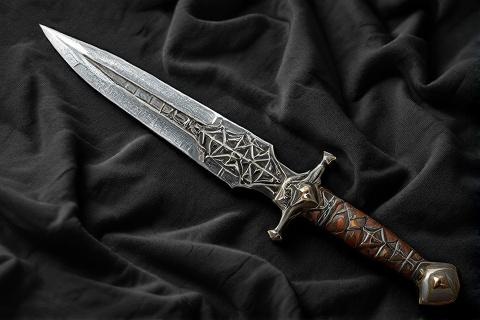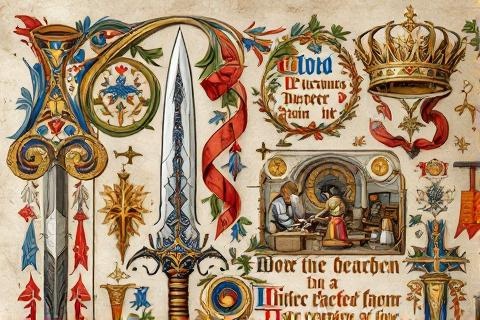
Angrist: The Blade That Cut a Silmaril
The Legendary Dagger of Beren's Quest
Origin in the Forges of Telchar

Among the greatest works of the First Age was Angrist, forged
by the legendary craftsman Telchar of Nogrod. Telchar's reputation as the most
skilled of all dwarven smiths was well-earned, for his works
included not only Angrist but also the mighty sword Narsil
and the Dragon-helm of Dor-lómin. His mastery of metallurgy and enchantment
surpassed all other dwarven craftsmen of his time.
The ancient dwarf-city of Nogrod, nestled in the Blue Mountains, was renowned as
a center of craftsmanship and metalwork during the First Age. Within its grand
halls and sophisticated forges, the dwarves developed techniques that would
become legendary throughout Middle-earth. The city's
location near abundant mineral deposits and its traditional rivalry with
neighboring Belegost drove its smiths to ever-greater achievements.
The creation of Angrist involved specialized dwarven techniques that remained
secrets of their craft. The blade underwent multiple stages of folding and
tempering, combined with ancient enchantments known only to the greatest dwarven
smiths. These methods imbued the weapon with its supernatural properties,
particularly its ability to maintain an edge that could slice through metal with
unnatural ease.
Physical Description and Properties
Angrist possessed a distinctive appearance that set it apart from ordinary
weapons. Its iron-black blade featured sharp, geometric patterns characteristic
of dwarven metalwork, with angles and facets that caught the light in unusual
ways. The dark coloration was achieved through special treatment of the metal
during its forging, a technique perfected in the forges of Nogrod.
The blade's edge possessed a keenness beyond any normal weapon, allowing it to
slice through iron and steel as easily as a common knife might cut leather. This
extraordinary property was not merely the result of exceptional sharpening but
was an inherent quality of the blade itself, woven into its very substance
during its creation.
The surface of Angrist bore intricate dwarven runes that proclaimed both its
maker's mark and the nature of its powers. These inscriptions, executed with the
precision characteristic of dwarven craftsmanship, served both as decoration and
as a record of the blade's provenance and capabilities. The runes themselves
were said to enhance and maintain the dagger's magical properties.
Though Angrist possessed tremendous power, it took the form of a hunting knife
rather than a full-sized sword or war blade. Its compact size made it ideal for
close work and precise cutting, while still allowing it to be carried easily at
one's belt. The weapon's dimensions were carefully calculated to maximize both
its utility and portability.
Journey to Thingol's Halls

Curufin, the fifth son of Fëanor, came to possess Angrist
through means not recorded in the histories, though some speculate it was given
as payment for his own smithwork. As one of the most skilled craftsmen among the
Noldor, Curufin would have recognized and appreciated the
exceptional quality of Telchar's work, making him a fitting, if ultimately
unworthy, owner.
During his years dwelling in Nargothrond, Curufin wore
Angrist at his belt as a symbol of his status and power. The great underground
realm served as a refuge for him and his brother Celegorm after they were driven
from their lands in the north, and there they wielded considerable influence
until their treachery against Beren was revealed.
The ownership of Angrist changed dramatically when Beren confronted Curufin and
Celegorm after their attempted betrayal. Following a violent encounter on the
borders of Doriath, Beren defeated Curufin in combat and
claimed the knife as his own. This transfer of ownership would prove crucial for
the success of Beren's later quest to recover a Silmaril
from Morgoth's crown.
Magical Properties
Angrist's most remarkable property was its ability to cut through iron and other
metals with supernatural ease. The blade could slice through the strongest steel
as if it were merely soft wood, a capability that set it apart from even the
finest normal weapons. This property made it uniquely suited for its eventual
role in Beren's quest to remove a Silmaril from Morgoth's crown.
The dagger possessed an innate resistance to magical barriers and enchanted
protections. This quality allowed it to overcome various forms of mystical
defense, though it would ultimately meet its match against the divine power of
the Silmarils. The blade's ability to pierce enchantments made it particularly
valuable in an age when magical protections were commonplace.
Through the sophisticated methods of its creation, Angrist maintained its edge
without need for sharpening. The dwarven enchantments worked into the blade
during its forging ensured that its cutting edge remained perpetually keen. This
self-maintaining quality was a hallmark of the highest achievements of dwarven
craftsmanship.
Role in the Quest for the Silmaril

When Beren and Lúthien infiltrated
Angband to fulfill their quest for a Silmaril, Beren
specifically chose Angrist for the crucial moment. The knife's unique properties
made it the perfect tool for their audacious plan to remove a Silmaril from
Morgoth's iron crown while the Dark Lord slept in his throne room. No other
weapon known in Middle-earth would have served this purpose so well.
In one of the most momentous acts of the First Age, Beren used Angrist to cut
through Morgoth's iron crown. The blade performed its task perfectly, slicing
through the seemingly impenetrable metal of the crown as if it were no stronger
than cloth. This achievement marked the only successful theft of a Silmaril
since Morgoth had stolen them from Fëanor.
After successfully freeing one Silmaril, Beren's confidence in Angrist's powers
led him to attempt to claim a second. The blade had proven its worth by cutting
through the crown once, and there seemed no reason it could not do so again.
This decision, born of either hope or pride, would prove to be the weapon's
undoing.
The Breaking of Angrist
The attempt to remove a second Silmaril proved to be Angrist's final act. The
blade, despite its extraordinary powers, shattered when Beren tried to cut a
second jewel from Morgoth's crown. This dramatic failure demonstrated that even
the greatest works of mortal craft had their limits when set against objects of
divine origin like the Silmarils.
When Angrist broke, a shard of its blade struck Morgoth's face, drawing blood
from his cheek. Though this wound would have been fatal to any mortal being, it
served only to cause the Dark Lord to stir slightly in his enchanted sleep. The
incident highlighted the vast gulf between even the mightiest works of the
Children of Ilúvatar and the power of a Vala.
The breaking of Angrist illustrated the boundaries of dwarven craftsmanship when
confronted with artifacts of divine power. While the blade could overcome nearly
any material or enchantment of Middle-earth, the holy light of the Silmarils,
combined with whatever spells Morgoth had placed upon his crown, proved too much
for even Telchar's masterwork.
Legacy and Historical Significance

Angrist's legacy endured long after its destruction, remembered as one of the
most remarkable weapons ever created in Middle-earth. Its role in the Quest for
the Silmaril earned it a place alongside other legendary items such as Ringil,
Glamdring, and Narsil in the chronicles of the Elder
Days. The tales of its deeds were preserved in both elven and dwarven histories.
The knife stood as a testament to the pinnacle of dwarven craftsmanship during
the First Age. Its creation demonstrated the heights that the smiths of Nogrod
could achieve, combining technical mastery with magical artifice in ways that
would never be equaled in later ages. The loss of such crafting techniques after
the destruction of Nogrod made Angrist's like impossible to replicate.
The blade's crucial role in the theft of a Silmaril from Morgoth's crown ensured
its place in the greatest tales of the First Age. This deed, part of the larger
story of Beren and Lúthien, became one of the most celebrated legends of
Middle-earth, retold countless times through the ages that followed. The tale of
Angrist's part in this quest was preserved in song and story by both elves and
men.
Throughout the ages that followed the First Age, Angrist served as inspiration
for countless stories and songs. Bards and loremasters would recount how a
dwarven blade played a crucial role in the greatest theft in the history of
Arda. The tale of its creation, powers, and ultimate fate became a reminder of
both the heights that mortal craft could achieve and its ultimate limitations
before divine power.
